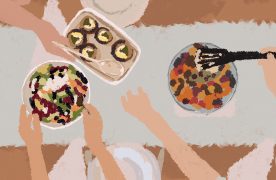Rich Moore is the director of Disney’s Wreck It Ralph, an animation film about a video game villain who questions his purpose and tries to break the mold by turning into a hero. Moore has been the director of animation for many programs, such as The Simpsons and Futurama. Film Editor Melissa Papalcure had the opportunity to chat with Moore on Wreck-It-Ralph and his love for the animation industry.
Melissa Papalcure: What is your favorite part of being a Director, and what prompted you to make a film about video games?
RM: Hmm, well, being a director or working in animation is something that I’ve always dreamed of since I was a kid. The first movie I ever saw as a child was The Jungle Book.
After having that experience of seeing that movie in the theater with my whole family, I knew that somehow I wanted to be involved in animation. As a little kid, I didn’t know what that meant, but I wanted to do whatever it was that made that stuff happen, that made it real.
Then I was very lucky upon graduating from Cal Arts, where I went to school for character animation. They actually give a degree in cartoons. I know it sounds strange. I graduated and I began working in the field of animation. I was very, very lucky to be in the right place at the right time with the right set of skills that I was working. I got a storyboard position on The Simpsons in the first year of that show.
MP: And what prompted you to make a film about video games?
RM: Well, I love video games. I grew up with them. I was lucky as a little kid. That’s when the first video games started to come out, like Asteroids and Pong.
Way back when TVs were made for watching and not interacting with. This was always fascinating to me. It’s been great watching the evolution of video games over, what, 35, 40 years. To see how far they’ve come. I started Disney in 2008, and I was developing ideas for a movie, which I would direct, and someone brought up the fact that they had been trying to crack an idea for a video game movie over the years at Disney with very little success.
It would go, you know, you are wasting your time at that arcade and no good will come of playing video games. So, I like to think I proved ‘em wrong.
MP: In the film, which specific world took the longest to develop?
RM: We have three distinct video game worlds in the movie, and that’s the world of Fix-It-Felix Junior. It’s all based on eight-bit design, and it’s very simple. It’s very blocky. Everything from the design to the camera work, to the lighting and the location is based on eight-bit and simplicity.
Then we have the world of “Heroes Duty,” which is supposed to be a modern game. It’s got a lot of detail and it’s lush, and there’s atmosphere and very dramatic lighting, and stuff floating in the air, and it’s dramatic. That was a challenge, we made it as realistic as we possibly could. And then the third one is “Sugar Rush,” which is a cart racer.
It’s like “Mario Cart” mixed with “Candy Land,” because everything in the world is made out of candy and sweets and cookies, you name it. That world is very whimsical and charming and kinda soft, and round, and playful. I would say that one, “Sugar Rush,” probably, provided the most challenge, because it is made out of cookies and cakes and food, you know.
MP: What was it like coming up with the most individual characters in the history of Disney?
RM: I’ll be honest — 190 characters does not seem like that much to me. Someone said we’ve got 190 characters in this movie. And I said oh cool, you know. Great. He said no, you have no —you don’t know. Tangled only had 60. I guess we’ve kinda broken a record, which I’m kinda proud of. But we needed that many characters. It’s a big movie and there are lots of locations.
Muse: Can you talk a little bit about what it was like to work with such an excellent cast, some of the industry’s best comedians like John C. Reilly, Sarah Silverman, Jane Lynch, Jack McBrayer?
RM: It is excellent, and it was amazing to work with those four, and Alan Tudyk also, he was King Candy. I’ve been a fan of all of ‘em. I love all of them, and the roles that they play, and their comedy. What’s great having worked with them now — I’m still a huge fan, but now I really love them as people. They’re just really wonderful people to know and to work with, so collaborative. They were right there, and they believed in the movie from early on.
John gave his all for this character and he was so invested in it. It’s not often that an actor in an animated film will call up and say “Can I come over, and can we talk a little bit more about Ralph?”
MP: In many films where the story is always focused on the good guy — why did you decide to switch the focus to the bad guy?
RM: Well, when we first started developing the story there was, there was a moment that myself and Phil Johnston, the writer, thought that the Felix’s character was going to be the main character of the movie. And in developing that idea it would be a movie about Mario in “Donkey Kong.”
We weren’t getting traction with it. It just didn’t make a lot of sense. And then there was a moment when Phil said, you know what? You know, what about, what about the bad guy character that we have here? At that point we used to call him Ralph Grubble for some reason.
Maybe that should be our main character. And it was at that point that I thought, yeah, I mean it’s more interesting to watch a story about Donkey Kong than Mario, especially if Donkey Kong is wondering why do I throw barrels at this guy? And why do people hate me for doing it, you know?
We came upon that whole thing, and that’s when the story really took off.
This is an account occasionally used by the Daily Free Press editors to post archived posts from previous iterations of the site or otherwise for special circumstance publications. See authorship info on the byline at the top of the page.













